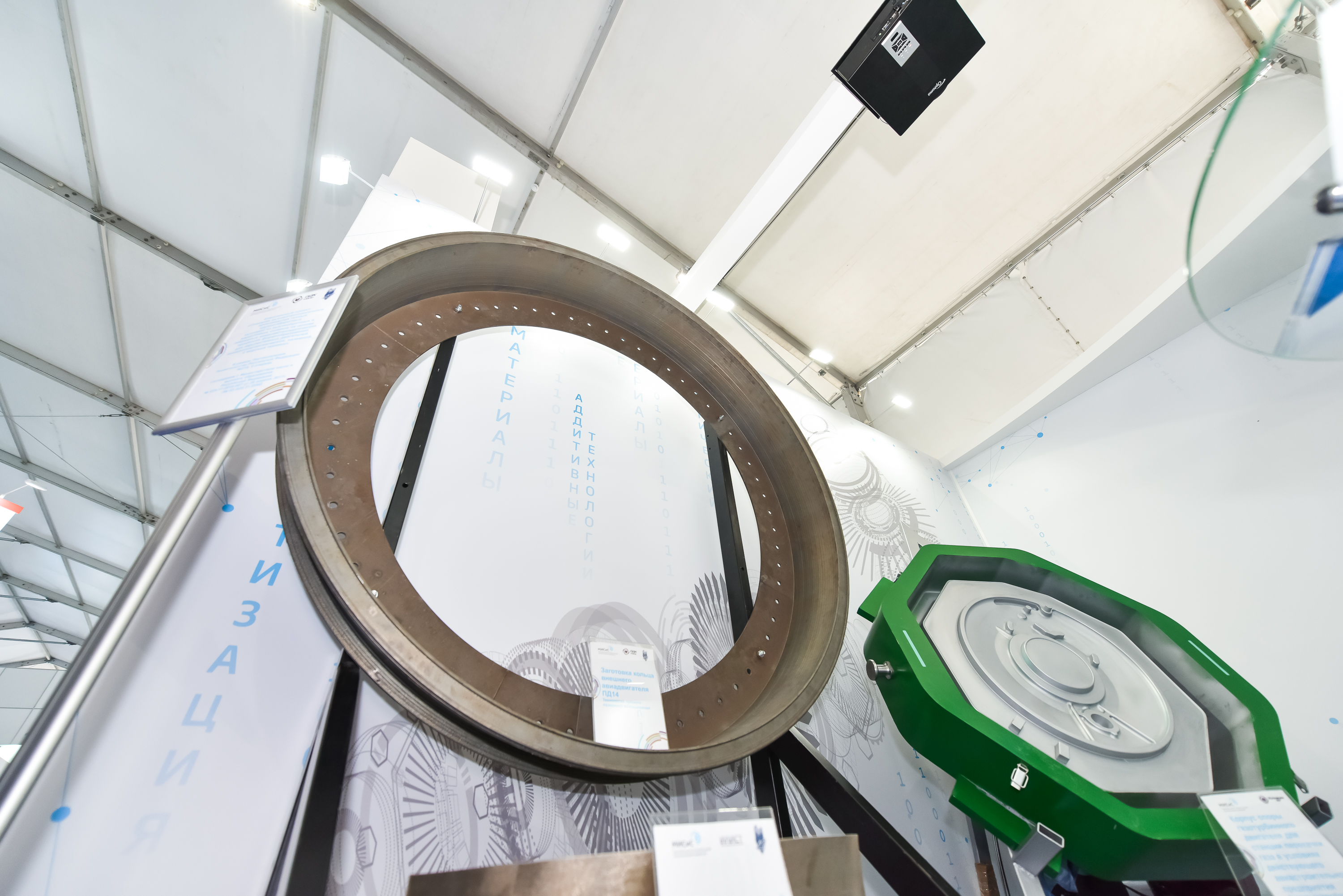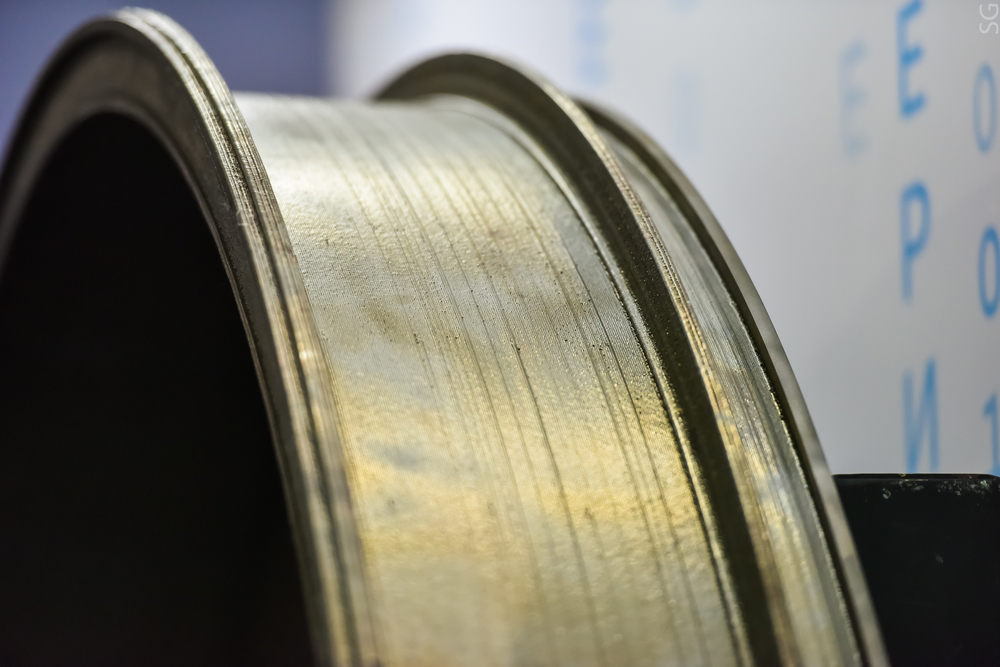For the first time in the world with the help of additive technologies, a large-sized aircraft engine assembly was obtained
The workpiece for the functional assembly of the promising Russian PD-14 engine, completely created by direct laser growth, was presented at the MAKS International Aviation and Space Salon. Thanks to the use of additive technologies, the total weight of the workpiece decreased by more than three times, and the manufacturing time was reduced to 130 hours. Developers: St. Petersburg State Marine Technical University (SPbGMTU) and NUST "MISiS".

Creation of competitive aircraft engines is impossible without the use of new generation materials and technologies in their design. Scientists at SPbGMTU and NUST “MISiS” suggested using direct laser growing technology to create the outer ring of the PD-14 engine. The first experimental sample of the billet was made at SPbGMTU using unique equipment of its own design.
“Direct laser growing is an additive technology that can significantly increase the efficiency of the production process. For example, the housing of a combustion chamber for a small gas turbine engine can be grown from scratch in 3 hours, while using traditional technologies, it will take about two weeks to make. In our case, it took about 130 hours to create a part blank, despite the fact that the dimensions of the blank are more than 2 meters in diameter. The mass of the workpiece has more than tripled. This means that the volume of subsequent machining is drastically reduced, accordingly, manufacturing time is reduced, production costs are reduced, thereby ensuring the competitiveness of domestic aircraft engines , ”said Andrei Travyanov , director of the EcoTech Institute of MISiS NITU.

To create the outer ring of the PD-14 engine, a titanium alloy was used, which in the form of a powder was supplied by a gas jet under a laser beam fusing it, providing a layered "growth" of the part. As a result, engineers passed the stages of casting, forging and rolling the workpiece. The production process accelerated by an order of magnitude, while the mechanical properties of the grown material are not inferior to metal products and significantly exceed the properties of cast products, which is confirmed by the results of mechanical tests carried out both in the laboratories of NITU MISiS and in independent laboratories, including the Central Plant Laboratory (TsZL )

Another technological advantage of using additive technologies when creating aircraft parts is that the designer sees the results in real time, and can quickly make the necessary changes. The process of designing and creating new equipment using this method is accelerated by tens of times. The technology makes it possible to combine several gas-powder jets and supply various materials to the growing zone, thereby creating products with gradient properties, that is, one part of the part can be corrosion-resistant and the other heat-resistant, which is especially important for the aerospace industry.
“The production of this sample was preceded by comprehensive theoretical and experimental studies: mathematical models of the process were developed, a large number of metallographic studies, tomography and radiography of the samples, mechanical tests were carried out, optimal regimes and growth strategies were determined, several models were made. During the growth of the prototype, several new technical solutions that are currently under legal protection. For example, growing with a horizontal laser beam, using a “dynamic” substrate to combat crack formation, technological methods for increasing process productivity, predicting thermal deformations and taking them into account in the technological model of the product when generating a control program to ensure the required accuracy of construction , ”emphasizes the project executive , deputy Evgeny Zemlyakov, Director for Research and Design Activities, Institute of Laser and Welding Technologies, SPbGMTU .
At present, tests are being prepared for the resulting engine assembly on the basis of one of the leading specialized engine-building enterprises in Russia. The start of industrial production is scheduled for 2020. The gained positive experience will also allow using the developed technologies in the design and manufacture of the PD-35 engine.

Creation of competitive aircraft engines is impossible without the use of new generation materials and technologies in their design. Scientists at SPbGMTU and NUST “MISiS” suggested using direct laser growing technology to create the outer ring of the PD-14 engine. The first experimental sample of the billet was made at SPbGMTU using unique equipment of its own design.
“Direct laser growing is an additive technology that can significantly increase the efficiency of the production process. For example, the housing of a combustion chamber for a small gas turbine engine can be grown from scratch in 3 hours, while using traditional technologies, it will take about two weeks to make. In our case, it took about 130 hours to create a part blank, despite the fact that the dimensions of the blank are more than 2 meters in diameter. The mass of the workpiece has more than tripled. This means that the volume of subsequent machining is drastically reduced, accordingly, manufacturing time is reduced, production costs are reduced, thereby ensuring the competitiveness of domestic aircraft engines , ”said Andrei Travyanov , director of the EcoTech Institute of MISiS NITU.

To create the outer ring of the PD-14 engine, a titanium alloy was used, which in the form of a powder was supplied by a gas jet under a laser beam fusing it, providing a layered "growth" of the part. As a result, engineers passed the stages of casting, forging and rolling the workpiece. The production process accelerated by an order of magnitude, while the mechanical properties of the grown material are not inferior to metal products and significantly exceed the properties of cast products, which is confirmed by the results of mechanical tests carried out both in the laboratories of NITU MISiS and in independent laboratories, including the Central Plant Laboratory (TsZL )

Another technological advantage of using additive technologies when creating aircraft parts is that the designer sees the results in real time, and can quickly make the necessary changes. The process of designing and creating new equipment using this method is accelerated by tens of times. The technology makes it possible to combine several gas-powder jets and supply various materials to the growing zone, thereby creating products with gradient properties, that is, one part of the part can be corrosion-resistant and the other heat-resistant, which is especially important for the aerospace industry.
“The production of this sample was preceded by comprehensive theoretical and experimental studies: mathematical models of the process were developed, a large number of metallographic studies, tomography and radiography of the samples, mechanical tests were carried out, optimal regimes and growth strategies were determined, several models were made. During the growth of the prototype, several new technical solutions that are currently under legal protection. For example, growing with a horizontal laser beam, using a “dynamic” substrate to combat crack formation, technological methods for increasing process productivity, predicting thermal deformations and taking them into account in the technological model of the product when generating a control program to ensure the required accuracy of construction , ”emphasizes the project executive , deputy Evgeny Zemlyakov, Director for Research and Design Activities, Institute of Laser and Welding Technologies, SPbGMTU .
At present, tests are being prepared for the resulting engine assembly on the basis of one of the leading specialized engine-building enterprises in Russia. The start of industrial production is scheduled for 2020. The gained positive experience will also allow using the developed technologies in the design and manufacture of the PD-35 engine.
All Articles